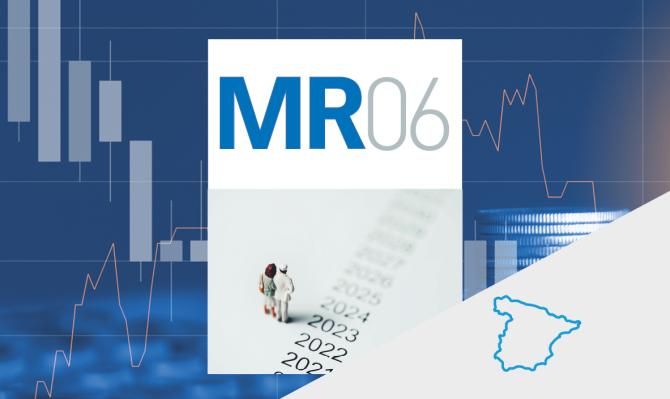Upward revision of Spain’sgrowth for 2023
On a positive note, the PMI for the services sector stood at 56.7 points in May, well above the level at which positive growth rates are usually observed (50 points), albeit below the level of the previous two months.

The encouraging Q1 2023 growth data published last month (0.5% quarter-on-quarter) alleviated fears of a recession in the short term, while the data published in the last few months have, in general, been better than expected. The improved economic outlook also supports the rapid moderation in energy prices witnessed in recent months. However, while 2% growth in a challenging context is certainly an encouraging development, it is important to note that much of this growth comes from the good performance of the foreign sector. Domestic demand, on the other hand, is weak, affected by the impact of the high inflation and rising interest rates (see the Focus «New economic scenario: the outlook improves for Spain» in this same report, for more information on the change in the macroeconomic forecasts).

On a positive note, the PMI for the services sector stood at 56.7 points in May, well above the level at which positive growth rates are usually observed (50 points), albeit below the level of the previous two months. The consumption-related indicators offer mixed signals. On the one hand, the retail trade index in real terms grew by 0.9% month-on-month in April and, if we exclude service stations from the tally, growth amounted to 4.1% month-on-month. In contrast, according to the CaixaBank consumer indicator, Spanish bank card activity slowed in April compared to the previous months and grew by 4.1% year-on-year (9.9% in March). This weakness has continued in the latest available data up until the first half of May. In turn, the industrial sector has continued to show weakness. In May, the PMI for the manufacturing sector fell 0.6 points and stood at 48.4 points, within contractionary territory (below 50 points). Overall, the scoreboard of indicators suggests that the economy is continuing to grow, but at a more moderate pace than in the previous quarter.

However, there is a slight moderation in the rate of job creation. Specifically, the number of registered workers rose by 200,411 people in May, slightly below the average for the month of May (214,000 on average in the period 2014-2019), and the year-on-year rate of growth moderated by 0.1 percentage points, to 2.9%. Correcting for seasonality, employment increased in the month by 47,883 registered workers, after growing by more than 100,000 in the previous two months. Unemployment, meanwhile, fell by 49,260 people to 2,739,110 people, which represents a smaller decline than usual in the month of May (–105,000 on average in the period 2014-2019).

Headline inflation fell sharply in May and stood at 3.2% year-on-year (4.1% in April), according to the CPI flash indicator published by the National Statistics Institute. The slowdown in prices was not dominated by base effects, as was the case in the previous two months, meaning that the signal that this moderation conveys is clear and, in this case, positive. In the absence of the breakdown, the National Statistics Institute pointed out that the containment of inflation was mainly due to an appreciable fall in fuel prices, as well as lower food inflation. Core inflation (which excludes energy and unprocessed food) also fell significantly, standing at 6.1% (6.6% in April). This was due to contained growth in the core CPI in month-on-month terms, which reaffirms the signs of an easing of price tensions.

Home prices based on valuations grew by 2.2% quarter-on-quarter in Q1 2023, compared to 0.5% in Q4 2022, although in year-on-year terms it continued to slow down (3.1% year-on-year compared to 3.3% in the previous quarter). In the same vein, the home price index based on repeat sales and produced by the College of Registrars also registered a significant increase in Q1 2023 (1.3% quarter-on-quarter, 5.4% year-on-year). The demand for housing, meanwhile, is showing signs of cooling. In March, the number of sales fell by 5.7% year-on-year. However, it is necessary to clarify that this moderation is based on a very high starting point. Despite the year-on-year decline, sales are still 30.4% above the level of March 2019 (pre-pandemic). Despite the rebound seen in Q1 2023, we expect to see a slowdown in home prices over the coming quarters, in a context of moderation in demand in the face of rising interest rates.

The deficit of the trade balance of goods stood at 6,578 million euros in Q1, 2.3 times less than a year ago (–15,416 million) and slightly below the average for the first quarters between 2014 and 2019 (–6,760 million). This result was the result of both the lower energy deficit and the notable improvement in the balance of non-energy goods. Thus, the energy deficit in Q1 fell to 8,218 million, compared to a deficit of 11,052 million in the same period of 2022, thanks to a lower volume of imports (–9.7%) in a context of lower prices (–1.1%). The balance of non-energy goods, meanwhile, registered a surplus of 1,639 million euros, marking the best Q1 figure since 2014 (deficit of 4,364 million in the same period of 2022), thanks to the greater buoyancy of exports (15.1% vs. 7.3% in the case of imports).



